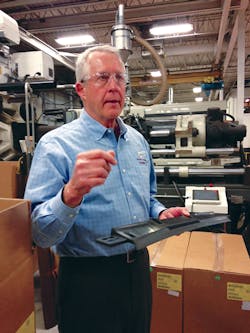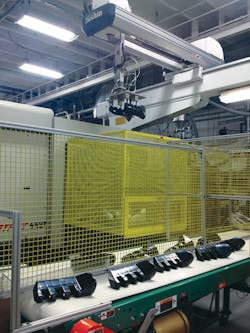Molder Venture embraces change, new technologies
If injection molding is becoming more of a science than an art form, custom molder Venture Plastics Inc., Newton Falls, Ohio, is bent on being its Edison.
The company constantly is adding to its repertoire, fueled by its strategy of addressing the needs of its key accounts. For example, one of its next areas of growth is in-mold labeling because an existing customer wants a camouflage decoration on a crossbow. But true to its nature, Venture will find ways to use the technology with other products. The company is well-diversified and growing in new areas. Its products include standby power components and automotive, solar and rail parts; as well as consumer goods, like brushes for floor cleaners. But no one market makes up more than 25 percent of Venture's business.
"We're seeing a market segment develop on the solar side that uses these battery systems; as you pull the sun's energy from the panels, it goes right into these battery systems," says President Steve Trapp. "It's a good market segment for us and one of our largest. Automotive is the second largest, and we service all types of automotive applications."
Trapp and Jim Smith, the company's VP of Ohio operations and engineering, recently sat down with Plastics Machinery Magazine to discuss the company's approach and the way it makes its capital investments. This is a company that is not shy about new technologies, as long as they support the needs of those key accounts.
The Ohio plant is 75,000 square feet and has 19 injection molding presses with clamping forces ranging from 55 tons to 720 tons. A 48,000-square-foot El Paso, Texas, plant has 15 presses with clamping forces from 55 tons to 950 tons. Venture is moving into larger tonnages, and it plans to buy a 1,250-ton press late this year. On the floor of its Ohio plant, Arburg and Milacron presses make components for the automotive, medical and appliance markets.
Venture's primary equipment investments were its focus in 2013 and 2014; in 2015 and into 2016, auxiliary equipment will be the focus. At the Ohio facility, officials recently added a Novatec central material handling system.
The company abides by an annual operating plan that starts with its sales division and an evaluation of where it expects growth in the coming year, says Trapp. With the goal of addressing the needs of key accounts, officials make decisions very early and methodically when buying equipment and technologies.
Supported by fundamental systems
Venture uses two fundamental systems for custom injection molding, says Trapp – software packages for systematic molding from RJG and enterprise resource planning from IQMS.
In addition to telling Venture what materials it needs to buy, the IQMS system monitors the performance of the machines in real time.
"I know what's running before I walk in the door," says Smith. "I check it when I get up in the morning; part of my morning routine is to see how things are going, so you can hit the ground running when you get in the door. You can see El Paso as well."
Having this type of support is critical, especially for preventive maintenance, says Smith. "With that real-time feedback, you count every shot. So you drive preventative maintenance work orders on the tools, on the equipment," he says.
In both Newton Falls and El Paso, Venture is counting on a system that measures the pressure of plastic flowing into the tools. The company has dealt with 300 different types of material in its Ohio plant alone; with Texas, add in another 100.
Trapp, who has a background in the resin industry, says this is a strategy to manage the injection molding process to account for the viscosity variance even in prime resins. These materials can range from a rigid PVC to highly filled nylons.
"All of the materials vary in viscosity from lot to lot," he says. "They can be prime materials, but they can vary in viscosity and that variance in viscosity creates different pressure requirements for the processor. This allows us to make adjustments as those different pressure requirements come in, and [the system] is one of the investments that Venture has made."
Smith says that it is one of the reasons that the company is running zero defects per million parts. At its Ohio plant, the company installed a process water system that saves a million gallons of water per year.
Implementing new technologies
In one case, Venture's appetite for exploring new technologies was supported by a grant from PolymerOhio Inc., Westerville, Ohio. A customer from the food-processing industry wanted to develop more robust components in one of its mixer systems.
"Rather than build tools, we 3-D printed the inserts that would fit into the tool that allowed us to test different materials," says Trapp. "So we 3-D printed those components, put those inserts into the tool and were able to sample two different materials to let them experiment."
This was a welcome, less expensive alternative to having the inserts cut from metal.
In another case, Venture is providing injection molded components with tufted, brushed fibers. These fibers can be natural, such as horsehair, or synthetic. This is done in a secondary operation and primarily was used in products for the floor-cleaning industry.
"We are looking at ways that we can take this into other industries," says Trapp. It seems the company has found at least one so far — the hunting goods industry.
"We're now taking that tufted fiber capability and putting it into a crossbow component, so that where the arrow had rested before on a non-tufted component, it now sits on a fiber and gives it a lot more flexibility and freedom to fly," he says. "This is technology that was in the appliance market segment that is now moving over to, in this case, the hunting industry. Perhaps it will go into medical, perhaps in automotive."
Robotics at work in the Ohio plant are Cartesian models, mostly from Yushin, that assist the machine operator by picking the parts from the molds.
Venture handles all of its own tool maintenance and had two technicians busily cleaning molds on the day of PMM's plant tour. Third parties, though, support mold building.
"We do provide U.S.-based tool sources, but we do go overseas if the economics are what the customer wants," says Trapp.
Metal-to-plastic conversions
Venture is seeing more work from products that were once made from metal. One of those products is a wheel chock used in the railroad industry. This is a segment that has had metal wheel chocks for years, but Venture has developed a very high fiber content product that is 60 percent glass fiber with nylon. Components are molded at Venture then shipped to Chicago for assembly. Smith emphasizes the need to design for manufacturability. Venture's engineers can make material recommendations and be a great support system if they are brought in at the beginning of a project. Sometimes, if they are not consulted at the beginning, it can become very expensive for the customer. By designing for manufacturability, customers can get faster cycle times, for example, going from a 2-minute cycle to a 1-minute cycle.
"That is important, particularly when you get on these larger tonnage presses," says Trapp. "You are paying for that big press. The faster you're moving parts through it, the less you're going to pay."
Venture also is seeing growth in products for the construction market, such as molded bases to support conduit on the roofs of commercial buildings. Trapp says it goes back to the key account strategy.
"How can we best support them? Whether it's a location, whether it's a piece of technology they're looking for, it all starts with the customer and to support that customer, we bring a very strong approach."
Angie DeRosa, managing editor
Contact:
Venture Plastics Inc., 330-872-5774, www.ventureplastics.com



